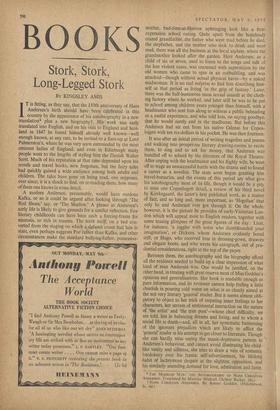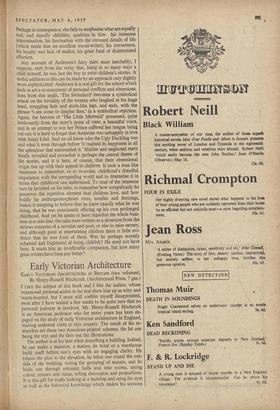BOOKS
Stork, Stork, Long-Legged Stork
BY KINGSLEY AMIS A modern Andersen, presumably, would have outdone Kafka, or so it could be argued after looking through 'The Red Shoes, say, or 'The Shadow.' A glance at Andersen's early life is likely to give grounds for a similar reflection. Few literary childhoods can have been such a forcing-frame for neurosis, so rich in trauma. The birth itself, on a bed con- 'erted from the staging-on which a defunct count had lain in state, even perhaps suggests Poe rather than Kafka, and other circumstances make the standard bullying-father, possessive- mother, bad-time-at-Harrow upbringing look like a free- expression school outing. Quite apart from the hopelessly crazed grandfather, the father who went mad before he died. the stepfather, and the mother who took to drink and went mad, there was all the business at the local asylum, where the grandmother looked after the garden. Here Andersen, as a child of six or seven, used to listen to the songs and talk' of the less violent cases, was crammed with superstition by the old women who came to spin in an outbuilding, and was attacked—though without actual physical harm—by a naked madwoman. It is no real suiprise to find him describing him- self at that period as living- 'in the grip of fantasy.' Later, there was the half-humorous mass sexual assault at the cloth- ing factory where he worked, and later still he'was to be put to school among children years younger than himself, with a headmaster who sent him along to witness a public beheading as a useful experience, and who told him, on saying goodbye. that he would surely end in the madhouse. But before this Andersen had set out from his native Odense for Copen- hagen with ten rix-dollars in his pocket. He was then fourteen.
It was after an initial period of writing tragedies and poems and walking into prosperous literary drawing-rooms to recite them, to sing and to ask for money, that Andersen was bundled off to school by the directors of the Royal Theatre. After coping with the headmaiter and his flighty wife, he went off to wage an unsuccessful battle with the drama and to found a career as a novelist. The state soon began granting him travel-bursaries. and the events of this period are what give his autobiography most of its life, though it would be a pity to miss one Copenhagen detail, a review of his third novel by Kierkegaard, the latter's first published work, as a matter of fact, and so long and, more important, so 'Hegelian' that only he and Andersen ever got through it. On the whole. however, it is the picture he provides of early-Victorian Lon- don which will appeal most to English readers, together with some teasing glimpses of the great figures of the day : Liszt, for instance, 'a juggler with notes who dumbfounded your imagination'; or Dickens, whom Andersen evidently bored stiff; or Hugo, who received him in dressing-gown, drawers and elegant boots, and who wrote his autograph, out of pru- dential considerations, right at the top of the paper. Perhaps in consequence, she fails to emphasise what are equally real, and equally childlike, qualities in him : his immense determination, his fascination with the outward details of life (which made him an excellent travel-writer), his irreverence, his loyalty and lack of malice, his great fund of disinterested affection.
Any account of Andersen's fairy tales must inevitably, I suppose, start from the verity that, being in so many ways a child himself, he was just the boy to write children's stories. A useful addition to this can be made by an approach only slightly more sophisticated: Andersen is a real gift for the school which finds in art a re-enactment of personal conflicts and obsessions. Seen from this angle, The Swineherd' becomes a symbolical attack on the triviality of the women who laughed at his huge head, straggling hair and stork-like legs, and ends, with the Phrase 'I am come to despise thee,' in a symbolical rejection. Again, the heroine of 'The Little Mermaid' possessed, quite irrelevantly from the story's point of view, a beautiful voice, and in an attempt to win her Prince suffered her tongue being cut out; it is hard to forget that Andersen was unhappily in love with Jenny Lind. And we all know who the Ugly Duckling was and what it went through before 'it realised its happiness in all the splendour that surrounded it.' Hidden and neglected merit finally revealed and rewarded is perhaps the central theme of the stories, and it is here, of course, that their obsessional origin ties up with their appeal to children. It took a man like Andersen to remember, or to re-evoke, childhood's dreadful impatience with thd unregarding world and to dramatise it in terms that childhood can understand. To read of the immense care he lavished on his tales, to remember how scrupulously he preserves the repetitive element that children love, and how boldly he anthropomorphises trees, needles and firetongs, makes it tempting to believe that he knew exactly what he was doing, that he was consciously offering up his own prolonged childhood. And yet he seems to have regarded the whole busi- ness as a side-line; the tales were written as a diversion from the serious concerns of a novelist and poet, or else to raise money, and although good at entertaining children. there is little evi- dence that he was fond of them. Was he perhaps secretly ashamed and frightened of being childish? He need not have been. It made,him an insufferable companion, but how many great writers have been any better?











































 Previous page
Previous page